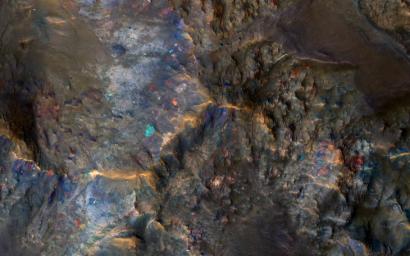
|
Raised Bedrock in Terra Cimmeria
- Click the image above for a larger view
- Full-Res JPEG (2880 x 1800) (734.0 kB)
- Full-Res TIFF (2880 x 1800) (15.6 MB)
Caption:

Map Projected Browse Image
Click on the image for larger version
Large impact craters have central hills or mountains, because the tremendous shock waves from the impact first compresses the ground, then causes a rebound when it becomes uncompressed. This effectively raises bedrock that was once deeply buried to the surface.
Furthermore, some of the most interesting bedrock on Mars is amongst the oldest and deeply buried. Thus, these crater central uplifts act as windows into ancient Mars, and enable us to peer into a time when certain geologic processes were more active than today.
The enhanced colors in this image reflect different bedrock compositions. Some of the large blocks are broken up and jumbled by this impact event or were resampled from previous large impacts.
This is a stereo pair with ESP_013092_1630 .
Background Info:
The University of Arizona, Tucson, operates HiRISE, which was built by Ball Aerospace & Technologies Corp., Boulder, Colo. NASA's Jet Propulsion Laboratory, a division of Caltech in Pasadena, California, manages the Mars Reconnaissance Orbiter Project for NASA's Science Mission Directorate, Washington.
Cataloging Keywords:
| Name | Value | Additional Values |
|---|---|---|
| Target | Mars | |
| System | ||
| Target Type | Planet | |
| Mission | Mars Reconnaissance Orbiter (MRO) | |
| Instrument Host | Mars Reconnaissance Orbiter | |
| Host Type | Orbiter | |
| Instrument | High Resolution Imaging Science Experiment (HiRISE) | |
| Detector | ||
| Extra Keywords | Color, Crater, Impact, Map, Mountain | |
| Acquisition Date | ||
| Release Date | 2017-01-05 | |
| Date in Caption | ||
| Image Credit | NASA/JPL-Caltech/Univ. of Arizona | |
| Source | photojournal.jpl.nasa.gov/catalog/PIA15149 | |
| Identifier | PIA15149 | |
